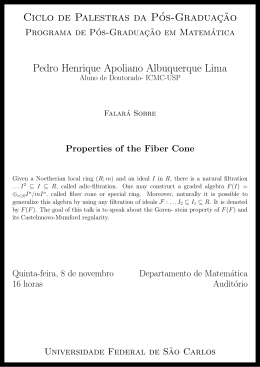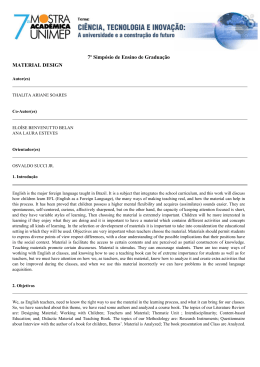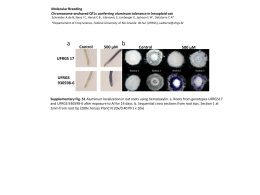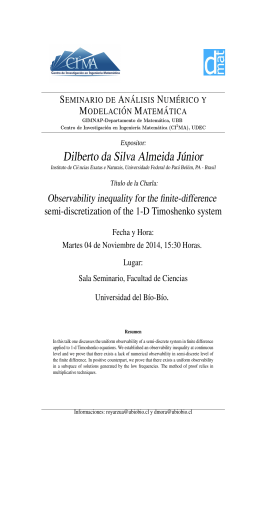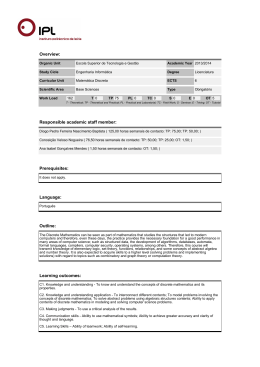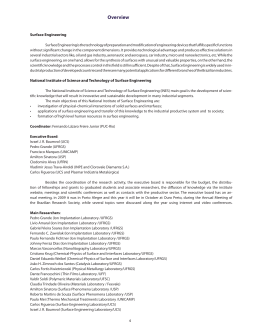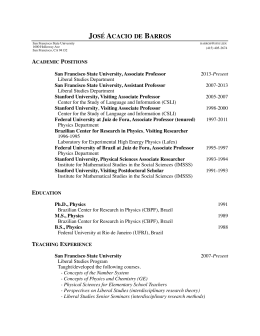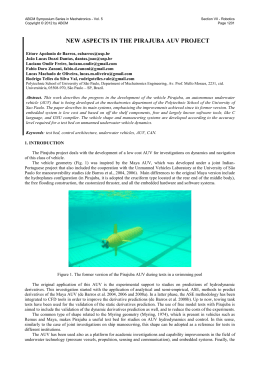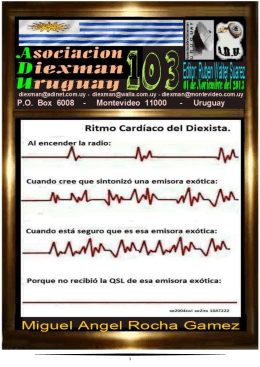Spectral Analysis of the Matrix for Three-dimensional Discrete Ordinates Problems Marco T. M. B.de Vilhena Eliete Biasotto Hauser∗ Depto. de Matemática - PUCRS Depto. de Matemática - UFRGS [email protected] [email protected] Ricardo Ricardo C. Barros Ruben Panta Pazos IPRJ - Universidade do Estado do Rio de Janeiro [email protected] [email protected] Based on a spectral analysis of the LTSN matrices, we describe a new algorithm to generate an analytical solution for discrete ordinates problems in three-dimensional cartesian geometry with isotropic scattering and one energy group that appear as: i h ∂ ∂ ∂ + ηm ∂y + ξm ∂z + σt Ψm (x, y, z) = µm ∂x Q(x, y, z) + Depto. de Matemática - UNISC M σs X wn Ψn (x, y, z) , 8 n=1 (1) where m = 1 : M are positive integer numbers, M = N (N + 2) is the cardinality of the discrete ordinates set, N represents the order of the angular quadrature, σt is the macroscopic total crosssection, σs is the diferential scattering cross-section, Q(x, y, z) the source term , Ψm (x, y, z) is the angular flux in the discrete direction Ωm = (µm , ηm , ξm ) and wm is the weight of the angular quadrature set used to model the transport problem (Lewis [9]). to generate the systems of linear algebric equations, that is (sI − Ax )Ψx (s) = Ψx (0) + S x (s), (sI − Ay )Ψy (s) = Ψy (0) + S y (s), (2) (sI − Az )Ψz (s) = Ψz (0) + S z (s). The solutions of the linear systems (2) are given by: Ψx (s) = (sI − Ax )−1 [Ψx (0) + S x (s)], Ψy (s) = (sI − Ay )−1 [Ψy (0) + S y (s)], (3) Ψz (s) = (sI − Az )−1 [Ψz (0) + S z (s)]. The entries of the matrix Az , with i = 1 : M and j = 1 : M , have the form 8σt − σsii wi se i = j − 8ξi az (i, j) = , (4) σsij wj se i = 6 j 8ξi T Ψz (0) = [ Ψ1z (0) Ψ2z (0) · · · ΨM x (0) ] , the vector of unknowns is T Ψz (s) = Ψ1z (s) Ψ2z (s) · · · ΨM z (s) (5) (6) and the vector Sz (s) has generic components i h x x µi − (0, s) − (a, s) S zi (s) = Qzξ(s) Ψ Ψ i i aξm i Figure 1: Ωm = (µm , ηm , ξm ), m = 1 : M 8 ,N = 4 Furthemore, we first transverse integrate the SN equations and then we apply the Laplace transform ∗ Partially supported by FAPERGS and CNPq − i ηi h y y Ψi (0, s) − Ψi (b, s) . bξi (7) In this work we describe the diagonalization Az = Vz Dz Vz(−1) , (8) where, Dz is the diagonal matrix of eigenvalues of Az and Vz the matrix of the respective eigenvectors. (−1) (−1) Similarly, Ay = Vy Dy Vy and Ax = Vx Dx Vx . This is possible from the complete description of the spectra of these matrices, because any eigenvalues are multiples(Tabel 1) but the respectives eigenvectors are independet lineary. Ψx (x) = [Vx eDx x Vx−1 ]Ψx (0) + [Vx eDx x Vx−1 ] ∗ Sx (x) , −1 Dy y −1 Ψy (y) = [Vy eD Vy ] ∗ Sy (y) , y yVy ]Ψy (0) + [Vy e Ψz (z) = [Vz eDz z Vz−1 ]Ψz (0) + [Vz eDz z Vz−1 ] ∗ Sz (z) . References N 2 4 6 8 10 12 14 16 σt ξ1 σt ξ2 σt ξ3 σt ξ4 σt ξ5 σt ξ6 σt ξ7 σt ξ8 3 7 11 15 19 23 27 31 3 7 11 15 19 23 27 3 7 11 15 19 23 3 7 11 15 19 3 7 11 15 3 7 11 3 7 3 [1] R. C. Barros, M. Yavuz, M. P .Abreu, Progress in Spectral Nodal Methods Applied to Discrete Ordinates Transport Problems, Progress in Nuclear Energy, 12-33 (1998), 117-154. [2] R. C. Barros, E. W. Larsen, A spectral Nodal Method for One-group X,Y-geometry Discrete Ordinates Problems, Nuclear Science and Engineering, 34-111 (1992), 34-45. [3] R. C. Barros, E. W. Larsen, A Numerical Method for One-Group Slab-Geometry Discrete Ordinates Problems, Nuclear Science and Engineering, 19-104 (1990), 199-208. Table 1: Multiples eigenvalues of Az for Ωm = (µm , ηm , ξm ),m = 1 : M 2 We assume a solution in the exponential form for the homogeneous equations associate with the onedimensional transverse integrated SN nodal equations. Therefore we obtain the eigenvalue problem M σs X αn wn , 8 n=1 M σs X αm (s)(σt + sηm ) = αn wn , 8 n=1 M σs X αm (s)(σt + sξm ) = αn wn . 8 n=1 αm (s)(σt + sµm ) = (9) [4] K. Case, E. Zweifel, “ Linear Transport Theory”, Addison-Wesley Publishing Company, 1967. [5] E.B.Hauser, M. T. B. Vilhena, R. C. Barros, Análise Espectral da Matriz LT SN para o Problema de Ordenadas Discretas Bidimensional Cartesiano com Fonte Fixa e Espalhamento Isotrópico , Tendências em Matemática Aplicada e Computacional, SBMAC, 3 ,2 (2002)135-140. [6] E. B. Hauser, R.P.Pazos, M.T.M.B.Vilhena, An Error Bound Estimate and Convergence of the Nodal-LTSN Solution in a Rectangle, Annals of Nuclear Energy, 32 (2005) 1146-1156. In order to determine the angular fluxes we apply the inverse Laplace transform to (3) −1 ] [7] E. B. Hauser,, Panta Pazos, R., Barros, £−1 [(sI − Az )−1 ] = £−1 [ sVz Vz−1 − Vz Dz Vz−1 R.C., Vilhena, M.T., Solution and study of Dz z −1 −1 −1 −1 Nodal Neutron Transport Equation applying Vz . = Vz £ [(sI − Dz ) ]Vz = Vz e the LTSN DiagExp Method. Proceedings of In [8] was determined two algorithms whose difthe 18th International Conference on Transference lies in the representation of the transverse port Theory, pp. 303307, Rio de Janeiro, leakage terms that appear in the transverse inBrazil,2003. tegrated SN two-dimensional equations. These terms in version LT SN 2D−Diag are written as lin[8] E. B. Hauser, ”Estudo e Solução da Equação ear combinations of the eigenvectors multiplied by de Transporte de Nêutrons Bidimensional exponential functions of the corresponding eigenvapelo Método LT SN Para Elevadas Ordens lues. As with in the LT SN 2D − DiagExp method, de Quadraturas Angulares: LT SN 2D - Diag the transverse leakage terms are represented by exe LT SN 2D - DiagExp”, Doctoral Thesis, ponential functions with decay constant depending PROMEC, UFRGS, Porto Alegre, RS, 2002. on the characteristics of the material associated to [9] E. Lewis, W. Miller, “Computational Methods the medium. of Neutron Transport”, John Wiley-Sons, New We proceed in a similar form with threeYork, 1984. dimensional problem and representing the convolution operation by ∗, we determine the analyti- [10] R. P. Panta, M. T. B. Vilhena, Convergence in cal matrix form for the edge-average angular flux Transport Theory , Applied Numerical Matheas function of the average angular flux at the bonmatics, 9 (1999),79-92. daries.
Download
